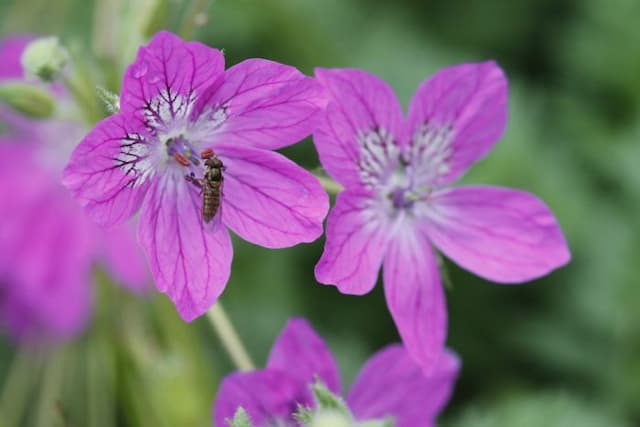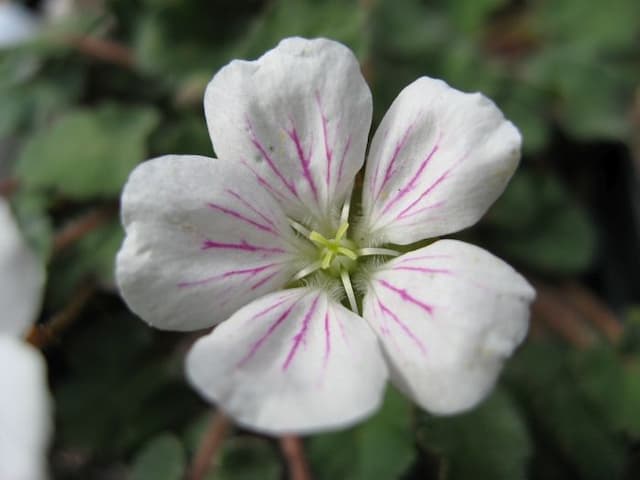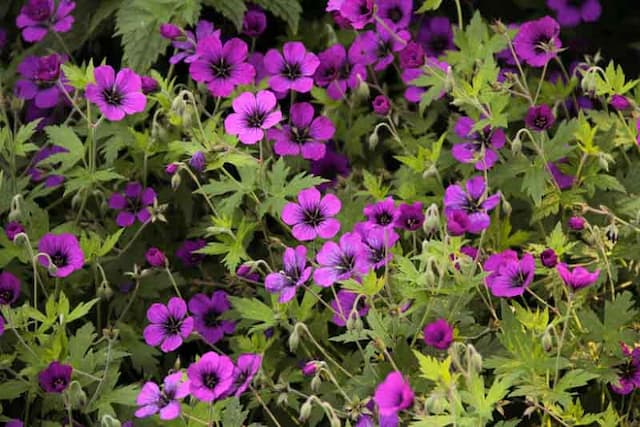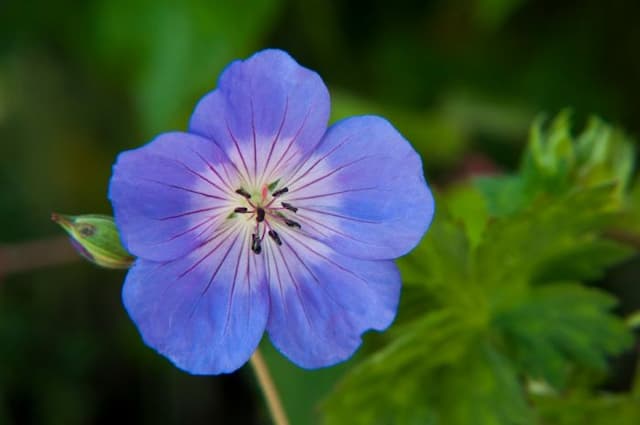Geranium Pelargonium 'Ann Hoystead' (R)
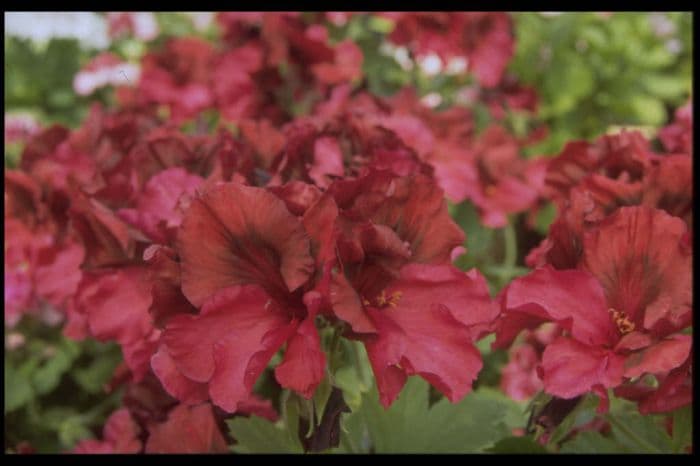
ABOUT
Pelargonium 'Ann Hoystead' is a visually striking plant that showcases a vibrant tapestry of colors and textures. The foliage of this variety typically boasts a lush, green backdrop, often with a unique zonal pattern that can be darker green or sometimes exhibit hints of maroon or bronze tones, particularly in the center of the leaf. These leaves are round to kidney-shaped with a softly scalloped or lobed edge, which adds a delicate touch to the overall robust appearance of the plant. The true showstoppers of Pelargonium 'Ann Hoystead' are its blooms, which come in clusters of magnificent flowers perched atop sturdy stems that rise from the lush foliage. Each flower is a work of art, presenting a rounded shape with petals that can range from bright pinks to rich purples. The petals may have a soft, velvety texture, and they often feature striking patterns, such as darker veins or a gradient of shades that create a sense of depth and vibrancy. These blossoms are known for their longevity, with the flowering season extending over a substantial period, which makes the Pelargonium 'Ann Hoystead' a favorite among garden enthusiasts and landscapers looking for long-lasting color. During its blooming season, the plant is a hub of activity, often attracting pollinators like bees and butterflies to its sweet nectar. Overall, Pelargonium 'Ann Hoystead' adds a splash of color and an element of sophisticated charm to any garden setting with its delightful blooms and attractive foliage. It embodies a fine balance between ornamental beauty and hardy resilience, making it a popular choice for those looking to enhance their outdoor or indoor spaces with living decor.
About this plant
 Names
NamesFamily
Geraniaceae.
Synonyms
Ann Hoystead Geranium, Ann Hoystead Pelargonium.
Common names
Pelargonium 'Ann Hoystead'
 Toxicity
ToxicityTo humans
Geraniums, including Pelargonium 'Ann Hoystead', are generally considered non-toxic to humans. However, if ingested in large quantities, they may cause mild upset stomach, vomiting, or diarrhea. There is no significant danger of serious poisoning from eating geraniums for most people. It is always prudent to avoid ingesting plants that are not meant for consumption.
To pets
Geraniums, including Pelargonium 'Ann Hoystead', are known to be toxic to pets, especially cats and dogs. If ingested, they can cause symptoms such as vomiting, lethargy, anorexia, depression, and dermatitis. In some cases, ingestion of geraniums can lead to more severe reactions and you should contact a veterinarian if you suspect your pet has eaten any part of the plant.
 Characteristics
CharacteristicsLife cycle
Perennials
Foliage type
Evergreen
Color of leaves
Green
Flower color
Mixed
Height
1-2 feet (30-60 cm)
Spread
1-2 feet (30-60 cm)
Plant type
Shrub
Hardiness zones
10
Native area
South Africa
Benefits
 General Benefits
General Benefits- Decorative: Pelargoniums, commonly known as geraniums, are popular for their vibrant and colorful flowers which embellish gardens and homes.
- Drought Tolerance: Geraniums are relatively drought-resistant, making them suitable for areas with limited rainfall or for gardeners who prefer low-maintenance plants.
- Easy Propagation: Geraniums can be easily propagated from cuttings, allowing gardeners to create new plants from existing ones without the need for seeds.
- Pest Resistance: These plants are often resistant to common garden pests, reducing the need for chemical pesticides and promoting a healthier garden environment.
- Long Blooming Season: Geraniums have a long flowering season, often blooming from spring through fall, providing a continuous display of color.
- Variety of Uses: They are versatile and can be grown in pots, hanging baskets, window boxes, and garden beds, making them suitable for various gardening designs and preferences.
- Attracts Pollinators: The flowers of geraniums attract beneficial pollinators such as bees and butterflies to the garden, supporting local ecosystems.
- Low Allergenicity: Geraniums are typically not known for causing allergies, which makes them a good choice for people with sensitivities.
- Adaptability: Geraniums can adapt to a variety of soil types, though they prefer moist, well-drained soil, making them a flexible option for various garden conditions.
- Easy Maintenance: These plants generally require minimal care, such as occasional deadheading and seasonal pruning, making them ideal for both novice and experienced gardeners.
 Medical Properties
Medical PropertiesThis plant is not used for medical purposes.
 Air-purifying Qualities
Air-purifying QualitiesThis plant is not specifically known for air purifying qualities.
 Other Uses
Other Uses- Creating perfumed products: The scented leaves of geraniums can be infused in oils or waters to create natural fragrances for homemade perfumes or room sprays.
- Flavoring food: Some geranium varieties are edible and can contribute a unique flavor to desserts, jellies, and teas.
- Companion planting: Geraniums are known to repel certain insects, thus are often planted alongside vegetables and other garden plants to act as a natural deterrent.
- Natural fabric dye: The leaves and flowers can be used to produce a range of dyes for fabrics, particularly for silk and wool.
- Artistic inspiration: The vibrant colors and shapes of geraniums have inspired artists and photographers, making them subjects for various forms of visual arts.
- Education and research: Due to the diversity among geraniums, they are sometimes used in educational settings to teach about plant hybridization and genetics.
- Crafting potpourri: Dried geranium leaves and petals can be included in potpourri mixes for a pleasant scent.
- Garden aesthetics: Geraniums are employed for their decorative value in garden design for borders, hanging baskets, or window boxes.
- Special events décor: Their attractive blooms and foliage make them popular choices for decorating venues for weddings, parties, and other events.
- Pressed flower crafts: The flowers of geraniums can be pressed and used in crafting, such as in making bookmarks, stationery, or decorative wall art.
Interesting Facts
 Feng Shui
Feng ShuiThe Geranium is not used in Feng Shui practice.
 Zodiac Sign Compitability
Zodiac Sign CompitabilityThe Geranium is not used in astrology practice.
 Plant Symbolism
Plant Symbolism- Comfort - The Pelargonium, more commonly known as Geranium, is often associated with comfort due to its homey and familiar scent.
- Friendship - Geraniums are believed to symbolize friendship and positive relationships as they are frequently shared among friends and gardeners.
- Health - Their use in traditional medicine has led geraniums to be seen as a symbol of health and recovery.
- Good Luck - Geraniums are sometimes considered to bring good fortune, particularly when gifted to someone starting a new venture.
- Happiness - With their bright and colorful flowers, geraniums represent happiness and a sunny outlook.
 Water
WaterGeraniums require moderate watering, and Pelargonium 'Ann Hoystead' is no exception. It is important to let the top inch of soil dry out between waterings to prevent overwatering and root rot. Typically, watering once every 7 to 10 days should suffice, but this can vary depending on temperature and humidity levels. When it is time to water, provide a thorough soaking until water runs out of the bottom of the pot, which may mean using approximately half a gallon for a standard-sized pot. During the winter months, reduce the frequency of watering as the plant's growth slows down.
 Light
LightGeraniums, including Pelargonium 'Ann Hoystead', thrive in bright light and will do best in a location where they receive at least 6 hours of sunlight per day. The ideal spot is in front of an east- or west-facing window that provides plenty of bright, indirect sunlight. However, it is important to protect the plant from the harsh, direct rays of the afternoon sun in hotter climates, which can cause the leaves to scorch.
 Temperature
TemperatureGeraniums, such as Pelargonium 'Ann Hoystead', prefer temperatures between 65 and 75 degrees Fahrenheit. They can survive in temperatures as low as 55 degrees at night and as high as 80 degrees during the day. To encourage blooming and robust growth, keep the plant in a location where it can enjoy steady, moderate temperatures and avoid sudden temperature drops or frost.
 Pruning
PruningPruning geraniums, like Pelargonium 'Ann Hoystead', helps to encourage bushier growth and more prolific flowering. Prune these plants in early spring before they begin their active growth or just after they've finished blooming. Remove any dead or yellowing leaves and spent flower stalks, and cut back leggy stems to promote a more compact shape. Depending on the plant's growth, selective pruning can be done every couple of months throughout the growing season.
 Cleaning
CleaningAs needed
 Soil
SoilGeranium 'Ann Hoystead' prefers well-draining, fertile potting mix with good organic content; aim for a soil pH between 6.0 and 7.0. Amend with perlite or sand to improve drainage and add compost for nutrients.
 Repotting
RepottingGeranium 'Ann Hoystead' should be repotted every 1 to 2 years or when it outgrows its current container, typically in spring before the new growth starts.
 Humidity & Misting
Humidity & MistingGeranium 'Ann Hoystead' tolerates average room humidity levels but does not require high humidity; keep in a well-ventilated area to prevent leaf problems.
 Suitable locations
Suitable locationsIndoor
Place in bright indirect light, ensure good airflow.
Outdoor
Full sun to partial shade, protect from harsh conditions.
Hardiness zone
9-12 USDA
 Life cycle
Life cycleGeranium 'Ann Hoystead' begins its life cycle when a seed germinates in warm, moist soil, usually in the spring. The seedling stage follows, where two primary leaves emerge, before true leaves develop and photosynthesis begins. The vegetative stage sees the geranium growing stems and more leaves, producing a bushy appearance as it matures. During the flowering stage, the geranium produces vibrant pink blooms that attract pollinators, essential for plant reproduction. After pollination, seeds develop within the flowers, which, once mature, are dispersed to begin a new life cycle. Finally, as temperatures drop in the fall, the geranium enters a dormant phase, reducing growth, with some species dying back to overwinter before resuming growth in the next season.
 Propogation
PropogationPropogation time
Spring-Early Summer
The most popular method for propagating Pelargonium 'Ann Hoystead', also commonly known as Geranium, is through stem cuttings. This typically takes place during the warmer months when the plant is actively growing, which is usually from spring through summer. To propagate by cuttings, a healthy stem about 4 to 6 inches (approximately 10-15 cm) long is selected. The cutting should have several leaves but the lower leaves are removed to expose a section of the stem. The cut end of the stem is then dipped in rooting hormone to encourage root development and planted in a moist potting mix. The pot is placed in a warm, bright location out of direct sunlight to avoid scorching the cutting. With proper care, roots will form in a few weeks, at which point the new Geranium plant can be transferred to a larger pot or planted outside.
